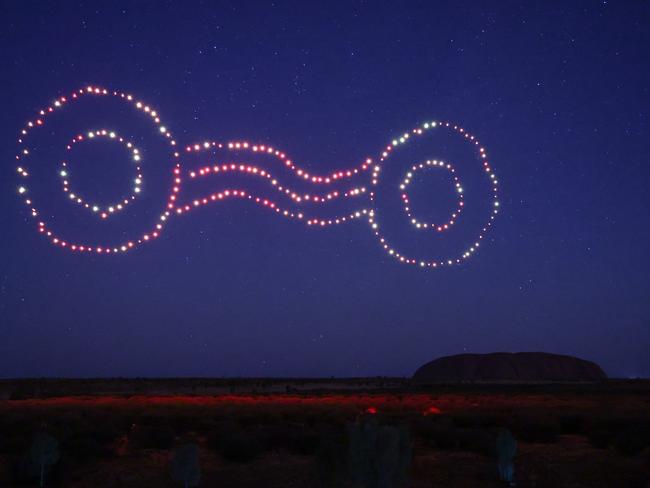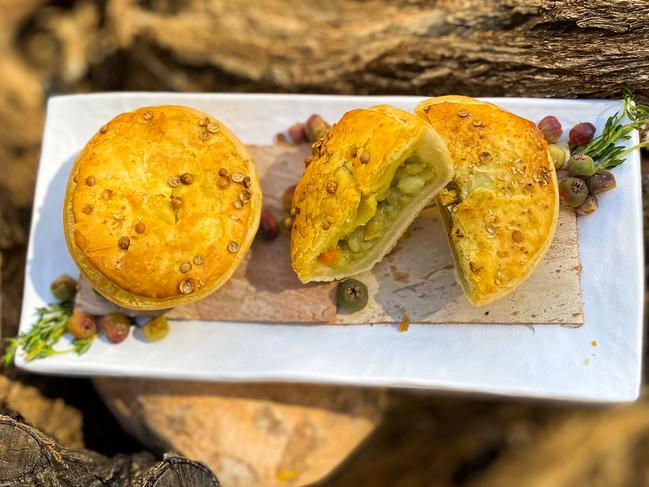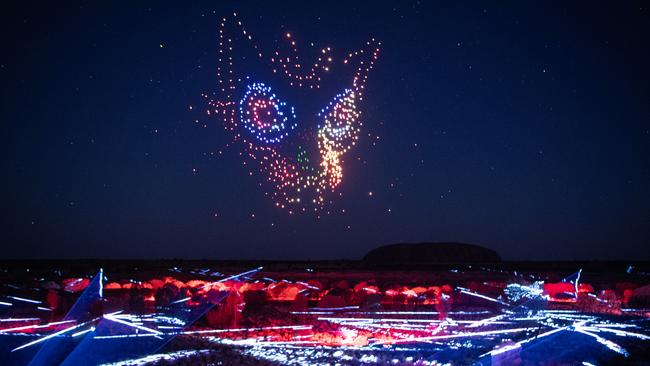Things to do at Uluru: drone show Wintjiri Wiru
Blanketed in stars, the Rock serves as the backdrop for a creative endeavour set to draw crowds to the mesmerising Red Centre.

The sun finally dips below the horizon, the last of its rays illuminating the colossal monoliths in Uluru-Kata Tjuta National Park. It’s the beginning of a long, glittering night in more ways than one. Blanketed in sparkling stars and the swirling Milky Way, Uluru serves as the backdrop for another creative endeavour set to draw crowds to the mesmerising Red Centre.
The latest production to set the desert alight is Wintjiri Wiru, a spectacular $10m drone show, the name of which translates to “beautiful view out to the horizon” in Pitjantjatjara.

Warding off the chill with supplied blankets, we take seats on a purpose-built viewing platform, where we are offered hot drinks or a rotation of cocktails and Penfolds wine. Chef Mark Olive’s pre-show canapes and hampers feature such delicacies as blackened pepperleaf kangaroo, smoked emu with saltbush chilli crust, gin-infused cucumber with green ants, and delicious mini lemon myrtle and crocodile curry pies.
The voices of the Anangu ring out into the night during a traditional inma (ceremony) as a welcome to the show. Laser lights and projections illuminate spindly oaks, mulga trees and spiky spinifex as the tale unfurls; music reverberates through the desert air from camouflaged speakers.

The Mala creation story is told in two Indigenous languages and English, but it is the 1269 drones taking flight about 20km from Uluru that bring it to life in waves of moving colour. The story begins with an invitation from the west for the Mala people to join an inma. The request is declined because a local ceremony is already underway. A devil dog called Kurpany is created and sent to wreak havoc and bring the inma to a violent conclusion. Luunpa, the Kingfisher Woman, sends a warning to the Mala people but is ignored. By the time Kurpany has been spotted, it is too late. It kills many of the men and spares the women, who flee south from Uluru.
We’re told the first iteration of the show was deemed too frightening by the Anangu, whose ancestral tales, or Tjukurpa, are told mostly in a simplified version suitable for children. Nonetheless, the snarling dog, brought to life by the drones, feels increasingly menacing as it gets closer and closer to the audience. Flashing lasers appear as cracks in the earth beneath it. The show culminates in Luunpa destroying the evil spirit. A traditional chorus replaces Kurpany’s threatening soundtrack as the drones move in sequence to the Mala songline. After 22 entrancing minutes, they land on their pads, darkness returns and guests drift to the shuttle buses, keen to return to the warmth of their accommodation.
The next day, on the Mala walk around the base of Uluru, Anangu guide Sammy Wilson points out physical evidence of the story. He highlights the honey-combed textured parts of the age-old rock, deemed the most sacred areas on its surface, where an unmistakable pawprint can be seen. It’s believed Luunpa and Kurpany still live here, their traces embedded into the geology forever.
Five years in the making, Wintjiri Wiru was funded by Voyages Indigenous Tourism Australia, which operates Ayers Rock Resort, and designed by Canadian-born light artist Bruce Ramus, of RAMUS, in close consultation with Anangu members.

“The ideas came from the country and they came from the land, and it was really our job to be open to that and to be open to the Anangu,” enthuses Ramus at the premiere of Wintjiri Wiru. “That’s how the idea was born. It wasn’t about technology. It was about responding to the scale and the beauty of this place and the depth of the storytelling on offer.”
“The first step is to acknowledge that the story belongs to the Anangu,” adds Voyages chief executive Matt Cameron-Smith. “First and foremost it (Wintjiri Wiru) honours culture and place.”
Imogen Reid was a guest of Voyages Indigenous Tourism.
In the know
Wintjiri Wiru runs every night until mid-December. Guests have the option of combining the show with a three-hour sunset dinner that includes cocktails and canapes; $385 an adult. A two-hour tour to see the performance costs $190 an adult, children, $95.
Anangu share the Mala story, from Kaltukatjara to Uluru, through a drone, sound and light show designed and produced by RAMUS.


To join the conversation, please log in. Don't have an account? Register
Join the conversation, you are commenting as Logout